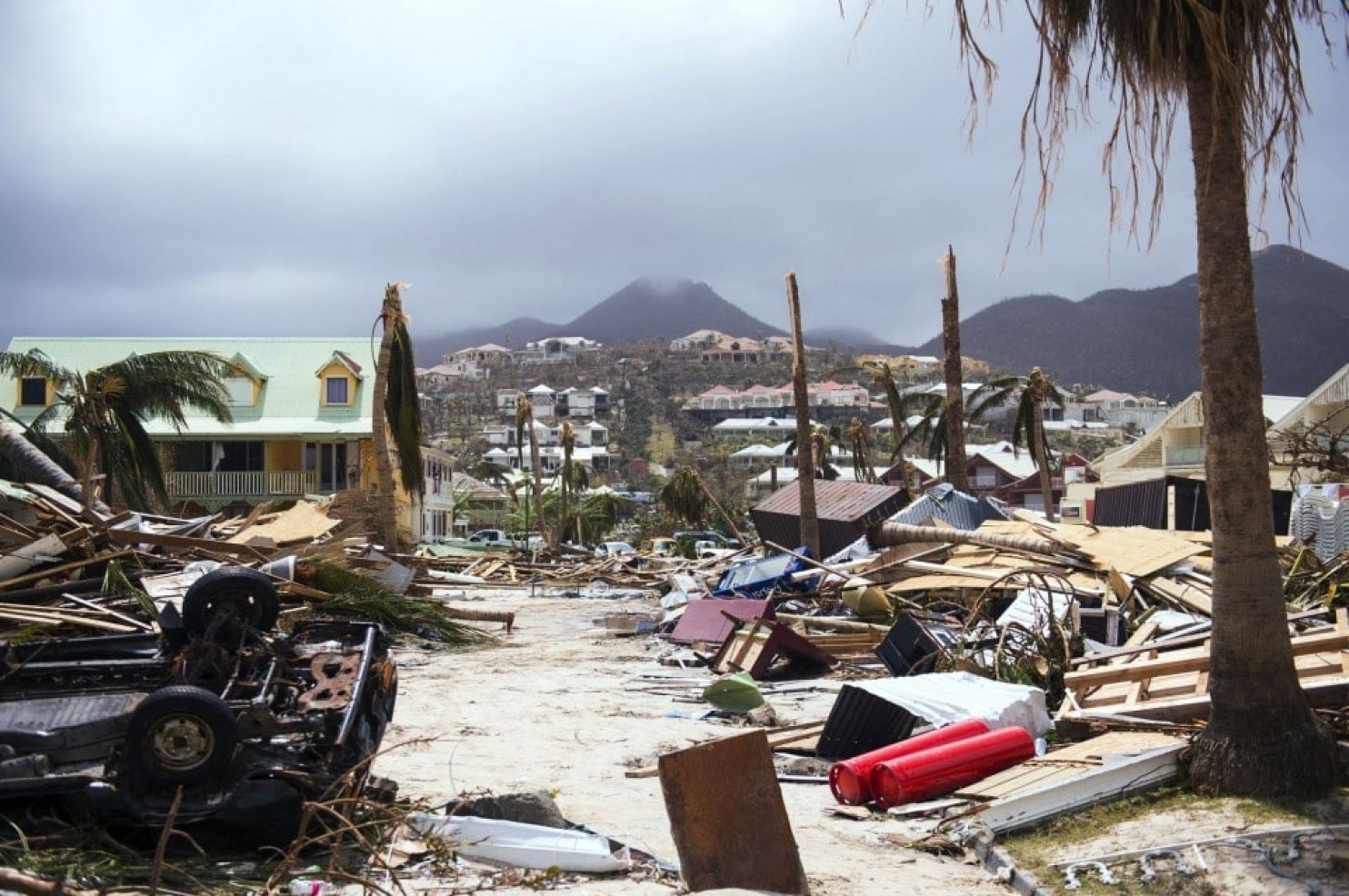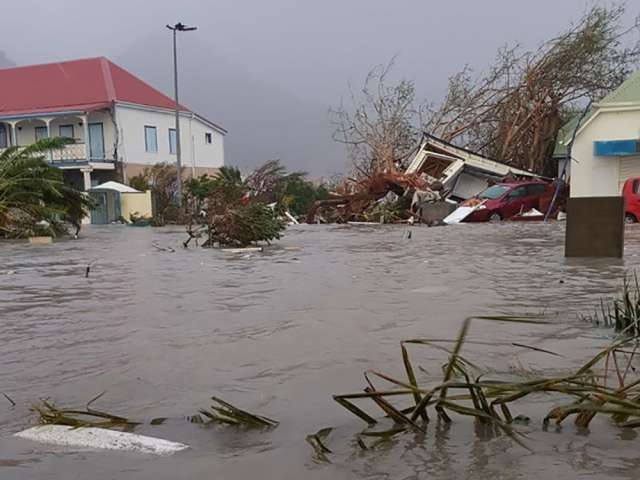
SINT MAARTEN GETS SMASHED BY HURRICANE IRMA: The apocalyptic pictures of the devastation.
PHILIPSBURG, Sint Maarten — Apocalyptic scenes of flattened buildings and ruined airports emerged from once-lush islands devastated by historic Hurricane Irma, as the deadly storm lashed vulnerable Haiti, where one government official called it a “nuclear hurricane” — even as another potent storm, Hurricane Jose, followed fast in Irma’s wake.
About 95 percent of the tiny islands of Barbuda and St. Martin sustained some damage or were outright destroyed, officials and local residents said. Ghastly photos and videos from St. Martin and St. Barthelemy, also known as St. Barts, showed buildings in ruin and cars and trucks almost submerged in the storm surge.
“Everything is a disaster, total devastation,” Dieter Schaede said by telephone from St. Martin, where he lives. “Roofs down, houses totally flown away, wiped out.”
Irma’s death toll has reached at least 16, a figure expected to rise as its punishing winds hit the Turks and Caicos Islands, and moved closer to a potentially disastrous assault on Cuba, the Bahamas and Florida.
For those on the islands already ripped apart by Irma’s ferocious winds, there is little time to regroup: The National Hurricane Center said on Friday that Jose is strengthening as it churns toward the Leeward Islands.
Hurricane watches and tropical storm warnings were in effect for Antigua and Barbuda, Anguilla, St. Barts and St. Martin as the National Hurricane Center noted that Jose’s sustained winds have been measured up to 150 miles per hour, with even stronger gusts.
“We are very worried about Hurricane Jose,” Gaston Browne, prime minister of Antigua and Barbuda, told The Washington Post by phone Thursday, adding that Irma had left about 60 percent of Barbuda’s nearly 2,000 residents homeless.
When Craig Ryan, a 29-year-old tourism entrepreneur who lives in Antigua, reached Barbuda by boat, residents lined the beach waiting for rescue. “It’s such a level of devastation,” he told The Post, “that you can’t even see structures standing.”
Ryan’s family business, Tropical Adventures Antigua, dispatched a 75-foot motorboat to make the 90-minute passage between islands to ferry people off Barbuda before Jose’s potential arrival. Some residents remain stuck in isolated areas blocked by impassable roads, he said by telephone as he loaded up water and other supplies at a dock in Antigua.
“We really are in a rush against time,” Ryan said.
On St. Martin, there was little sense that authorities had the situation under control. Witnesses said supermarkets were being looted, with no police visible in the streets; France’s minister for overseas territories, Annick Girardin, even described “scenes of pillaging” on the island.
“It’s like someone with a lawn mower from the sky has gone over the island,” Marilou Rohan, a European vacationer on the Dutch side of St. Martin, which is split with France, told the NOS news service. “Houses are destroyed. Some are razed to the ground. I am lucky that I was in a sturdy house, but we had to bolster the door, the wind was so hard.”
Occasionally, soldiers have passed by, but they were doing little to impose order, Rohan said.
“People feel powerless. They do not know what to do. You see the fear in their eyes,” she said.
On Friday, Dieter Schaede picked his way through the rubble-filled side streets of Cole Bay, trying to absorb the scale of the destruction on St. Martin. Schaede, a longtime resident of the island and the owner of a local realty firm, had difficulty putting into the words the havoc before him.
“People are in shock,” Schaede said. “I’m in front of a house that was a house. The only thing you see is a kitchen wall.”
With electricity out and communications down, Schaede said the horror stories are just starting to filter through the community. “Houses have been totally wiped out, with people in it,” he said. “We don’t know the end of the disaster.”
He added: “It’s terrible. It will take a couple years to rebuild.”
President Trump owns an 11-bedroom beachfront estate on St. Martin, perched on the sands of Plum Bay. The status of the property, which is currently for sale for $16.9 million, is still unknown. But Schaede said that he has heard that other homes in the neighborhood were severely damaged.
“I’m sure it was probably devastated,” he said of Trump’s property. “He is on the Atlantic side. That got hit pretty hard.”
Schaede rode out the storm inside a bathroom of a concrete building with his five children. All are safe. His building has a generator that gets turned on at night, to ration gas.
“We were one of the fortunate ones,” he said. “As along as we are alive, we can rebuild. We were very lucky.”
(A photo provided by the Dutch Defense Ministry shows storm damage in St. Martin in the aftermath of Hurricane Irma. Significant damage was reported on the island, which is split between French and Dutch control.)
The United States and European countries scrambled to send aid to the battered Caribbean islands.
The Pentagon deployed three Navy ships, nearly two dozen aircraft and hundreds of Marines to help with recovery efforts in Puerto Rico and the U.S. Virgin Islands, where they were needed to relocate hospital patients and others displaced by the storm, and haul in relief supplies.
One ship, the USS Wasp, was off St. Thomas on Thursday coordinating medical evacuations. Two others, the USS Kearsarge and the USS Oak Hill, were expected to be in position by Friday.
The military will provide generators, fuel and gas, water-purification systems and tools to clear roadways choked with storm debris, according to U.S. Northern Command. The Army Corps of Engineers sent teams to both U.S. territories to help restore electricity, and National Guard personnel were activated to help with evacuations and search-and-rescue efforts.
As of Thursday night, no other countries had asked for the U.S. military’s help, one official said, but Defense Department planners were preparing as though such requests may come.
“It’s safe to say things may progress,” John Cornelio, a spokesman for Northern Command, said. “I don’t want to get ahead of ourselves, but one of the things DOD can provide is capacity.”
Meanwhile Virgin Islands Water & Power Authority spokesman Jean Greaux said Friday morning that WAPA would make restoring power to the Schneider Regional Medical Center & Hospital and the Cyril E. King International Airport the first priority in St. Thomas.
Gov. Kenneth Mapp said that people in St. Thomas have been cutting WAPA electric lines (that are not energized) in order to clear paths for vehicles on the roadways, but that this practice will delay the full restoration of electricity to the capital island even longer — Mapp asked citizens to stop doing that
In St. John, where government officials have not visited nor reported on the damage there, only satellite phones are working and a passenger ferry is flipped up on one of the docks, eyewitnesses told the Virgin Islands Free Press. WSTA-AM Lucky 13’s Addie Ottley said that he could see sailboats sunk in the harbor in Cruz Bay from his vantage point at the radio station.
Gov. Kenneth Mapp said that people in St. Thomas have been cutting WAPA electric lines (that are not energized) in order to clear paths for vehicles on the roadways, but that this practice will delay the full restoration of electricity to the capital island even longer — Mapp asked people to stop doing that while talking to Ottley over the radio from St. Croix. The governor said that he planned to fly to St. Thomas this afternoon.
Mapp added that the federal government must pronounce the territory’s ports open in order for emergency and WAPA workers to travel to St. John to begin the process of assessing the damage there and then beginning to restore electricity.
As night began to fall Thursday, the most powerful storm ever recorded in the Atlantic Ocean was punishing the poorest country in the Western Hemisphere — Haiti, a nation still recovering from a massive 2010 earthquake and Hurricane Matthew last October. That storm, bearing Category 4 force when it made landfall Oct. 4 along Haiti’s southwest coast, killed more than 500 people on the island and injured more than 400 others.
As Irma moved away from the vulnerable nation, assessments by aid organizations began in the flood-prone north. The storm passed further off the coast than some had predicted, and very preliminary indications suggested the hit had perhaps not been as bad as feared.
Nevertheless, there were indications of severe damage in some communities. Houses in Malfeti, a municipality of several thousand near the northeastern city of Fort Liberty, were flooded “until the roofs,” according to Fort Liberty Mayor Louis Jacques Etienne, who is also responsible for smaller nearly municipality.
“It is completely underwater, until the roofs!” Etienne said by phone after surveying the damage himself.
Etienne, who dubbed Irma a “nuclear hurricane,” added that in Fort Liberty itself, a city of 37,000, houses had collapsed and roofs had flown off homes.
“Crops are destroyed, cattle is dead, and my cities are broken. It is bad. Very very bad,” he said.
Prime Minister Jack Guy Lafontant’s office issued a national notice advising citizens to return to work on Friday, while saying the government “is implementing actions to help the population to adequately face this natural disaster.”
Haiti’s Civil Protection Agency reported early Friday that one person was missing and three were wounded, including two in the northern town of Dondon when a tree collapsed on their house. A third person was wounded in the northern city of Cap-Haïtien.
The agency reported, “moderate flooding” in four northern provinces, and said a bridge linking Haiti to the Dominican Republic had collapsed in the border city of Ouanaminthe.
Gonaives, a low-lying northern city highly prone to devastating flooding, was a major concern in Haiti. But Mayor Neil Latortue said the damage had “not too bad at all.” Some trees fell outside the city limits, and debris filled the streets. But he said no major damage had been reported.
“We are trying to get businesses back up and running today,” he said.
Elsewhere in the Caribbean, French officials said St. Martin is without electricity, fuel and drinking water. About 800 rescuers arrived Thursday and more were on the way.
French Interior Minister Gérard Collomb said that “even the strongest buildings are destroyed” on the French side of St. Martin, while French Prime Minister Édouard Philippe said that four people had been found dead there and another 50 were injured.
In addition, four people were reported killed in the Virgin Islands, according to authorities there who described “catastrophic” damage.
There was at least one death reported on the British island of Anguilla, another on Barbuda and one on the Dutch part of St. Martin.
In Puerto Rico, Irma knocked out nearly half of the 1,600 cellphone towers on the financially strained island, leaving many residents without service, local media reported. More than 1 million people lost power. The island’s power authority had warned before the storm that damage could leave some neighborhoods without electricity for up to six months because of precarious infrastructure.
In the Dominican Republic, which shares Hispaniola with impoverished Haiti, the civil defense director, General Rafael A. Carrasco, said at least 2,721 homes have been damaged. The government said nearly 7,000 people had been evacuated from their homes, and 7,400 tourists had been moved from beachside hotels in Bavaro, Puerto Plata and Samana to the capital, Santo Domingo.

